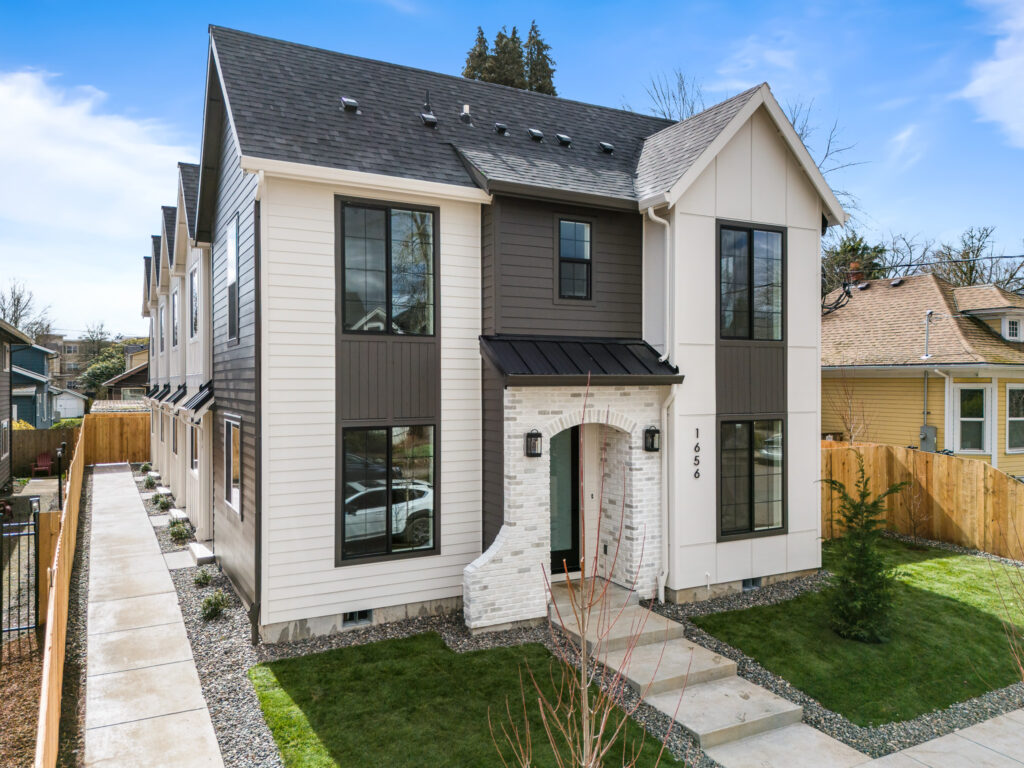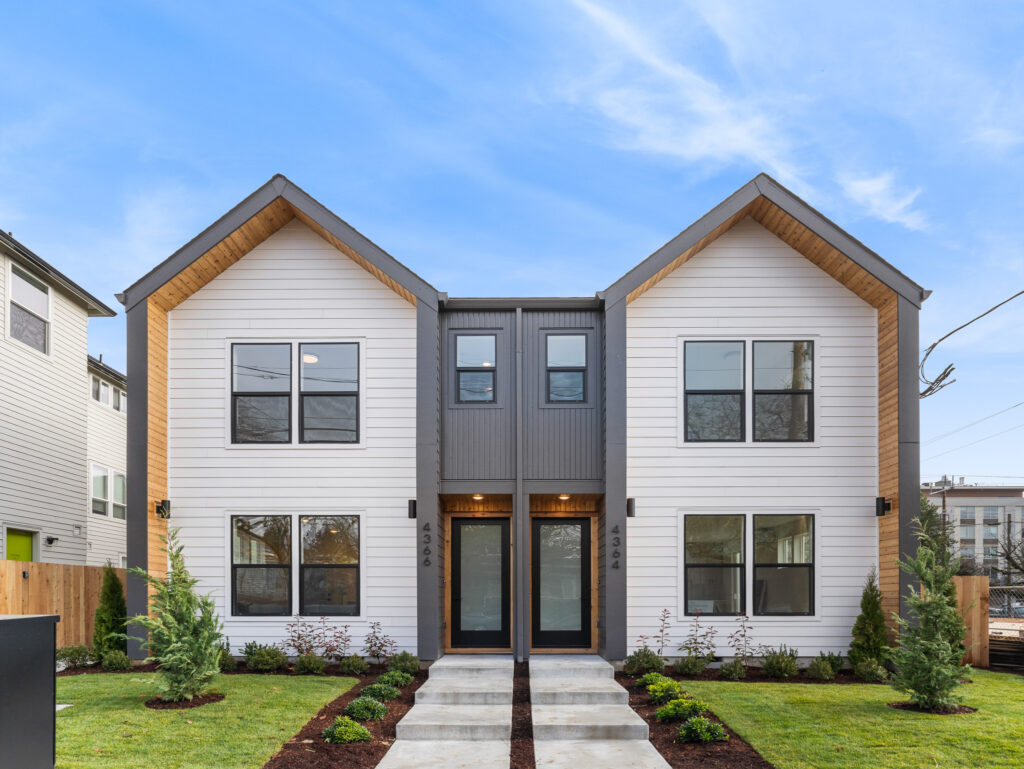Introduction
In just over a decade, Aker Development has completed over 300 residential units across Portland and surrounding areas. From single-family infill homes to multi-unit developments, each door we’ve built carries more than just square footage — it represents planning, partnerships, and persistence. Our journey of building 300+ doors in 10 years has shaped our approach to construction.
Building 300+ doors in 10 years isn’t just a milestone. It’s a mirror: reflecting the challenges we’ve overcome, the systems we’ve honed, and the values we stand by. In this article, we’re sharing the most impactful lessons we’ve learned — not just to celebrate our past, but to guide the future of construction in Portland.


Lesson 1: Pre-Construction Planning Is the Foundation
Every successful project starts long before demo or excavation. The most efficient builds are rooted in deep pre-construction planning, something we’ve prioritized on every Aker Development project.
That means zoning research, early budget alignment, and identifying client goals before the first subcontractor is even looped in. With Portland’s evolving land use and zoning policies, understanding lot coverage, ADU allowances, and RIP (Residential Infill Project) rules has become essential. Learn how we approach infill development.
One example comes from a recent four-unit project near Alberta Park, where early engagement with city planners helped us resolve a tight setback constraint well before permitting. That proactive move saved our client nearly six weeks and over $20,000 in redesign fees.
By aligning scope, budget, and site limitations up front, we’ve reduced rework, saved time, and gained client trust from the start.
Lesson 2: Quality Details Define Long-Term Value
We’ve learned firsthand that great framing, sealed penetrations, and sharp finish work do more than look good — they minimize callbacks and improve a building’s performance over time.
Subtle choices like precise window flashing or aligned trim aren’t just cosmetic. They’re functional decisions that prevent water intrusion, reduce maintenance needs, and ultimately boost resale value. These standards align with the National Association of Home Builders’ guidance on quality craftsmanship and warranty prevention.
Take, for example, a recent 10-unit townhouse project where we upgraded from standard to self-adhered flashing at key junctures. Though this choice added minor upfront cost, it helped prevent water infiltration during Portland’s wet season — a decision that earned the developer strong praise from their HOA and reduced service calls in the first year of occupancy.
We approach each project with a “future occupant” mindset. We ask ourselves: will this detail still work and look good in five, ten, or fifteen years?
Lesson 3: Cutting Corners Costs More in the Long Run
When you’re juggling timelines and labor availability, the temptation to take shortcuts can be real. But one of the most expensive lessons in our early years was that quick fixes often lead to long-term failures.
Improper insulation, skipped air sealing, or low-quality mechanical installs may not reveal issues immediately, but they show up later — often in the form of energy loss, system inefficiencies, or even mold.
We once inherited a partially completed duplex project where another builder had missed key sealing steps in the attic assembly. Fixing the issue after drywall was installed cost the new owner thousands in mold remediation and weeks of delays. Since then, our team has adopted strict internal QC checkpoints for MEP rough-ins and envelope work.
Our team now follows a zero-shortcut philosophy. Every aspect of a build gets done the right way, the first time, even if it means a few extra days upfront. In the long run, that commitment translates to stronger builds and fewer headaches for owners and developers alike.
Lesson 4: Strong Project Management Makes Scaling Possible
You can’t build 300+ doors without structured processes. Juggling multiple active sites, city inspections, and subcontractor schedules requires a disciplined project management approach.
We’ve developed internal systems that allow our teams to:
- Coordinate multiple subcontractors across phases
- Stay compliant with city requirements and permit timelines
- Mitigate supply chain delays with proactive sourcing
- Adjust for weather conditions and material lead times
One strategy we’ve adopted is centralized material tracking using cloud-based software, which allows our project leads to forecast deliveries, update partners in real time, and identify bottlenecks early. On a recent 22-unit build, this system prevented a potential month-long framing delay by identifying a sheathing shortfall two weeks before it would have become critical.
These aren’t just operational wins — they’re key to maintaining our client relationships and staying competitive. The Project Management Institute emphasizes that disciplined scheduling and communication are critical drivers for on-time, on-budget construction delivery.
Lesson 5: Good Relationships Are Just as Important as Good Plans
Relationships are the invisible scaffolding that supports every build. The value of trusted subcontractors, responsive suppliers, and transparent communication with clients can’t be overstated.
From structural framers to HVAC crews, we’ve built a trusted trade network that allows us to consistently deliver on quality and schedule. But the relationship work doesn’t stop there. Regular communication with clients — especially during long or phased projects — ensures alignment, trust, and fewer surprises.
We’ve found that collaborative, open relationships often lead to smoother jobsites and better outcomes. Many of our longest-standing subcontractor relationships go back five or more years — a testament to mutual respect, timely payments, and clear expectations.
Lesson 6: Construction Trends Are Always Evolving — Stay Ahead
The past 10 years have brought sweeping changes to the industry:
- Code updates that require higher energy performance
- Growing demand for Accessory Dwelling Units (ADUs)
- The shift toward climate resilience and green materials
- An emphasis on smart home systems
As Portland adapts its urban housing strategy — including through initiatives like the Residential Infill Project — builders must remain agile. Aker has embraced the push toward smaller footprints, higher efficiency, and tech-ready homes, giving us an edge in both new construction and redevelopment projects.
We’ve also integrated blower door testing, energy modeling, and smart home integration into many of our newer builds. These additions position our projects as both marketable and forward-thinking.
We also anticipate continued demand for infill and missing-middle housing — types of projects where our experience and scale make us a trusted partner.
Bonus Insight: Know When to Say No
One of the lesser-discussed lessons we’ve learned is the value of passing on a project that isn’t a fit. Whether it’s a misaligned timeline, unrealistic budget, or conflicting values — knowing when to walk away has protected our team, our reputation, and our clients.
Not every opportunity is worth pursuing, and the discipline to say no has been a quiet but essential part of our growth.
Recap: What Building 300+ Doors Has Taught Us
- Thoughtful planning saves time and money
- Quality construction reduces long-term risk
- Relationships are more powerful than technology
- Project management is key to growth
- Industry trends matter — adapt or fall behind
- Sometimes the best decision is to walk away
Want to see these lessons in action? Explore our featured multi-family projects.
Conclusion: Building Forward
Reaching 300 doors was never the goal — building them well was. At Aker Development, we’ve grown by staying committed to quality, process, and people. Every project we take on is shaped by what we’ve learned and refined across hundreds of homes and units.
We’re excited for the next 300, and we’re just getting started.
If you’re planning a project in Portland and want a partner with proven systems and deep local experience, we’d love to connect.
